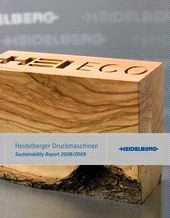Business News
Sustainable Printing Makes Customers More Competitive

Tuesday 15. September 2009 - Heidelberger Druckmaschinen AG publishes its sustainability report for the 2008/2009 financial year
Environmental protection and sustainability are two of the greatest challenges of our time. Printshops and their customers are increasingly adopting a green approach and expecting the same from those they work with. Heidelberger Druckmaschinen AG (Heidelberg) has just published its Sustainability Report 2008/2009, which proves that it is possible to print green and still be cost-effective. “Whether in our development and production activities or through the support we offer customers on issues relating to green printing, we play a key role in promoting environmentally friendly printing – a fact that is particularly true in tough economic times,” states Stephan Plenz, member of the Management Board responsible for Technology & Operations at Heidelberg. The report is just under 30 pages long and is divided into sections covering the environment, business, and social responsibility. There is also a section with key figures.
Integrated environmental approach
Sustainable print production is not restricted to energy-saving presses that conserve resources. It covers the entire process chain from prepress to postpress. The report’s environment section, for example, describes how the Prinect integrated printshop workflow cuts energy consumption and waste. In prepress, the impressive Suprasetter A52/A75 CtP platesetter uses five times less power and generates five times less waste heat than comparable models from other manufacturers. And in postpress, the intelligent makeready processes of the Stahlfolder KH 82 folding machine can save up to 2.5 tons of paper a year.
The report also details how Heidelberg systematically promotes environmental protection at all its sites – including production sites in Germany, assembly sites in Qingpu, China, and customer demonstration centers in the United Kingdom and Canada. Heidelberg customers in the U.S. also benefit from advice and support on environmentally friendly solutions.
In the report’s business section, too, printshops and their end customers are the main focus. For example, this section includes details of the winners of the HEI ECO Printing Award announced at drupa 2008. A total of more than 50 printshops from five continents took part and the prizes went to Canada and Japan. Heidelberg initiated this award in order to provide customers with a platform for passing on and discussing their good ideas. The relevant know-how is also documented in a dedicated eco section on the Heidelberg website.
Examples of successful green customers and tips for a green printshop A considerable amount of space is devoted to the profiles of two printshops from Germany and Australia. Both demonstrate that environmental protection and business success can go hand in hand and even win new customers.
Readers of the report will also be interested to discover the twelve steps to a green printshop. These range from tips on the use of paper, ink, and alcohol-free printing to staff motivation, energy management, and financing. The interview relating to the CO2 calculator devised by the bvdm (German Association of Print and Media) describes how printshops can calculate the CO2 footprint of jobs if their customers so request.
The report concludes with a section on social responsibility.
